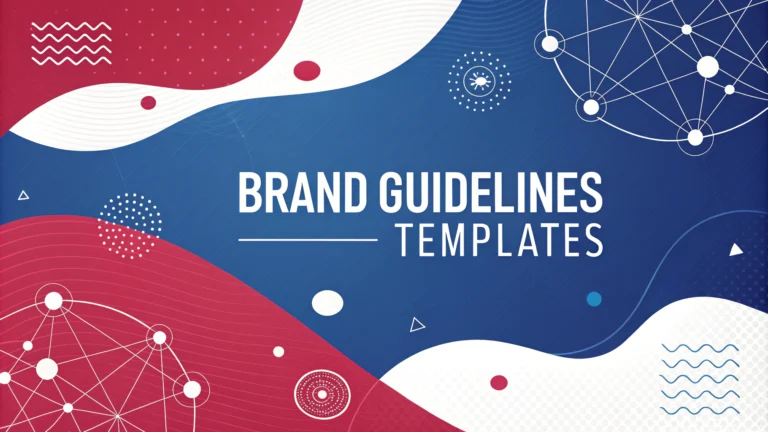Brand guidelines templates help maintain consistency across your logo design and overall visual identity.
A well-structured brand guidelines template includes these essential sections:
- Logo usage rules and variations
- Color palette with hex codes
- Typography specifications
- Image style guidelines
- Brand voice and tone
- Design elements and patterns
Start your template with a clear mission statement and brand story section.
Logo Design Guidelines
- Minimum size requirements
- Clear space rules
- Approved color variations
- Incorrect usage examples
Free Brand Guidelines Templates
| Platform | Features |
|---|---|
| Canva | Drag-and-drop interface, pre-made layouts |
| Adobe Express | Professional templates, easy customization |
| Figma | Collaborative editing, developer handoff |
Download editable templates from creative marketplaces like Creative Market, Envato Elements, or GraphicRiver.
Quick Tips for Creating Brand Guidelines
- Use real examples of brand applications
- Include downloadable logo files
- Add visual do’s and don’ts
- Keep updating as your brand evolves
Create separate sections for print and digital applications.
Essential Logo Files to Include
- Vector files (.ai, .eps, .svg)
- Raster files (.jpg, .png)
- Black and white versions
- Reversed versions for dark backgrounds
Store all brand assets in a cloud-based system like Dropbox or Google Drive for easy team access.
Recommended Tools
- Adobe InDesign: Professional layout design
- Frontify: Brand management platform
- Sketch: Digital design toolkit
Document any special printing requirements or paper stocks for physical applications.
Contact Information Section
Include a dedicated page with brand manager contact details and approval processes.
For questions about brand guidelines:
- Brand Manager Email: [email protected]
- Design Support: [email protected]
- Asset Request Form: company.com/brand-assets
Implementation Strategy
- Train team members on guidelines usage
- Create accessible digital documentation
- Schedule regular review sessions
- Establish feedback channels
Digital Asset Management
Implement a centralized system for storing and accessing brand assets:
- Organized folder structure
- Version control system
- Asset naming conventions
- Access permission levels
Brand Guidelines Distribution
- Interactive PDF format
- Online brand portal
- Mobile-friendly version
- Offline documentation
Maintenance and Updates
Schedule regular reviews of brand guidelines to ensure continued relevance:
- Quarterly asset audits
- Annual comprehensive review
- Change documentation process
- Version history tracking
Conclusion
Effective brand guidelines templates serve as the foundation for consistent brand representation. Regular updates, proper documentation, and easy accessibility ensure successful implementation across all platforms and touchpoints.
Remember to maintain flexibility while preserving core brand elements, allowing your visual identity to evolve while remaining recognizable.
FAQs
- What essential elements should be included in brand guidelines templates?
Logo specifications, color palette, typography, spacing requirements, minimum size requirements, clear space rules, acceptable and unacceptable logo usage examples, file formats available, and brand voice guidelines. - What file formats should be included for logo files in brand guidelines?
Vector formats (AI, EPS, SVG), raster formats (PNG, JPEG), both color and monochrome versions, and different size variations for digital and print applications. - How should color specifications be presented in brand guidelines?
Colors should be specified in multiple formats: CMYK for print, RGB for digital, Pantone/PMS for specialty printing, and hexadecimal codes for web use. - What are the standard logo variations that should be included in guidelines?
Primary logo, secondary logo, logo mark/symbol alone, wordmark alone, vertical and horizontal arrangements, monochrome versions, and reversed versions. - How should typography specifications be presented in brand guidelines?
Primary and secondary typefaces, web-safe alternatives, font weights and styles, hierarchy for different applications, and specific use cases for each font. - What are the crucial logo spacing rules to include in guidelines?
Clear space requirements (exclusion zone), minimum size requirements for both print and digital, and grid-based construction guides for proper scaling. - How should logo misuse examples be presented in guidelines?
Visual examples showing incorrect color usage, improper scaling, unauthorized modifications, wrong backgrounds, and inappropriate positioning. - What sizing specifications should be included for different platforms?
Minimum logo sizes for print materials, digital platforms, social media profiles, favicon specifications, and mobile applications. - How should co-branding guidelines be addressed in the template?
Rules for logo placement in partnership situations, spacing requirements between logos, size relationships, and approved co-branding arrangements. - What accessibility considerations should be included in brand guidelines?
Color contrast ratios for accessibility compliance, alternative logo versions for different backgrounds, and guidelines for ensuring logo visibility across all applications.








